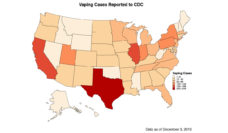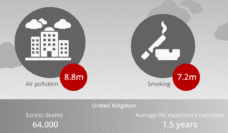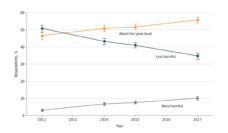National data from 2019 show that 28 percent of high school and 11 percent of middle school students use e-cigarettes. This represents a continued increase over the past three years. National data also show that retailers specializing in tobacco products, such as vape shops, are the second-most common source for e-cigarettes among youth. Recent research indicates that students who go to schools near these shops are more likely to vape. Hence, vape shops pose environmental health risks.
Similarly, youth who live in neighborhoods with many tobacco retailers are more likely to use tobacco. For traditional tobacco products like cigarettes, we know that high retailer density (number of shops in a geographic area) is associated with increased intent to smoke, and smoking prevalence. This environmental injustice contributes to tobacco-related health disparities. Environmental justice is achieved when all people have equal protection from environmental and health hazards and live, work, and go to school in healthy environments. Reducing exposures to environmental health risks can reduce health disparities and promote health equity for minority and low-income communities.
We wanted to know if specialty vape shops are concentrated in areas where minority and low-income youth live and attend school. To answer this question, we did an environmental justice assessment following the guidelines provided by the federal interagency working group on environmental justice. We counted the number of vape shops and mapped their proximity to public schools in public school districts throughout the United States. We examined whether the density of vape shops and their proximity to schools were related to the proportion of racial/ethnic minorities and those living in poverty.
Overall, our study adds to growing evidence informing policy efforts that promote environmental justice and protect youth from negative health effects of tobacco use.
We found a higher density of specialty vape shops located close to schools in school districts with large Asian and Black/African-American populations. However, vape shops were farther away from schools in school districts where many people live in poverty. These findings were recently published in a special issue of the journal Health Promotion Practice focused on tobacco and health equity.
Our findings raise environmental justice concerns about exposure to vape products and advertisements among Asian and Black/African-American youth. While e-cigarette use is higher among non-Hispanic White than non-Hispanic Black/African-American youth, data from the National Youth Tobacco Survey for 2018 and 2019 show that the gap is narrowing.
Environmental justice assessments can inform tobacco control policies. Previous research has shown that retailers in racial/ethnic minority communities are more likely to sell tobacco products to minors. Therefore, our results may help prioritize targeted enforcement actions in vape shops near schools. School district administrators may prioritize and target efforts to curb youth vaping in communities with many vape shops close to schools. These efforts could include health education curricula, such as tobacco toolkits, for urban schools. Local governments may enact policies restricting the promotion and sale of vaping products close to schools. Overall, our study adds to growing evidence informing policy efforts that promote environmental justice and protect youth from negative health effects of tobacco use.
Authors’ Disclaimer: The views and findings reported in the article are those of the authors and do not necessarily represent the official position of the Food and Drug Administration.
Photo by wild vibes on Unsplash















